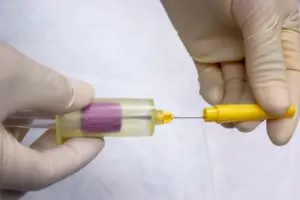Phlebotomy, often regarded as the backbone of modern healthcare, plays a crucial role in medical diagnostics by drawing blood samples from patients. Phlebotomists are skilled professionals trained in venipuncture techniques and handling blood specimens accurately. But what does a phlebotomist make an hour? Let’s delve into this question and explore the factors influencing their salaries.
Table of Contents
ToggleIntroduction to Phlebotomy
Phlebotomy is a vital aspect of healthcare, ensuring the proper collection and handling of blood samples for various medical tests and procedures. Phlebotomists work in hospitals, clinics, laboratories, blood banks, and other healthcare settings.
Importance of Phlebotomists
Phlebotomists are indispensable members of the healthcare team, responsible for collecting blood samples with precision and care. Their expertise ensures accurate test results, aiding in disease diagnosis, monitoring, and treatment.
Factors Affecting Phlebotomist Salaries
Education and Training
Phlebotomists usually undergo specialized training programs, which can vary in length from a few weeks to several months. Those with advanced certifications or degrees may command higher salaries.
Experience
Experience plays a significant role in determining a phlebotomist’s earning potential. Those with several years of experience often earn more than entry-level phlebotomists.
Location
Phlebotomist salaries exhibit significant fluctuations depending on the geographical area. Typically, urban locales or regions characterized by a higher cost of living tend to provide more lucrative compensation packages compared to their rural counterparts.
Average Hourly Pay for Phlebotomists
According to the Bureau of Labor Statistics (BLS), the median hourly wage for phlebotomists in the United States is around $17.00. However, these figures can fluctuate depending on variables like individual experience, geographical region, and the specific employer.
Highest Paying Industries for Phlebotomists
Phlebotomists working in specialized hospitals, diagnostic laboratories, and outpatient care centers tend to earn higher wages compared to those employed in physician’s offices or ambulatory healthcare services.
Job Outlook for Phlebotomists
The demand for phlebotomists is expected to grow in the coming years due to an aging population and advances in medical technology. This trend is projected to create job opportunities and potentially increase salaries in the field.
Benefits of Pursuing a Career in Phlebotomy
Apart from competitive salaries, a career in phlebotomy offers job stability, flexibility, and the satisfaction of making a difference in patients’ lives. Additionally, phlebotomists can explore opportunities for career advancement in related healthcare fields.
Challenges in the Field
Despite its rewarding aspects, phlebotomy can be physically demanding and emotionally challenging. Phlebotomists may encounter difficult patients, stressful situations, and the risk of exposure to bloodborne pathogens.
Steps to Becoming a Phlebotomist
To pursue a career in phlebotomy, individuals typically need to complete a training program, obtain certification, and gain practical experience through internships or on-the-job training.
Certification and Licensing Requirements
Employers often lean towards or mandate that phlebotomists hold certifications from reputable organizations like the National Phlebotomy Association (NPA) or the American Society for Clinical Pathology (ASCP). It’s worth noting that the specifics of certification and licensing regulations can vary from state to state.
Tips for Success as a Phlebotomist
Successful phlebotomists prioritize patient care, maintain professionalism, and continuously update their skills and knowledge through continuing education and training programs.
Career Advancement Opportunities
Phlebotomists can advance their careers by pursuing additional certifications, specializing in areas such as pediatric phlebotomy or donor phlebotomy, or transitioning into roles such as medical laboratory technician or nurse.
Impact of COVID-19 on Phlebotomist Salaries
The COVID-19 pandemic has highlighted the essential role of phlebotomists in healthcare. While some phlebotomists experienced temporary layoffs or reduced hours during the pandemic, others saw increased demand and potential salary enhancements due to their critical role in COVID-19 testing and vaccination efforts.
Conclusion
In conclusion, the hourly wage for phlebotomists varies based on factors such as education, experience, location, and industry. Despite the challenges, a career in phlebotomy offers competitive salaries, job stability, and opportunities for professional growth. As healthcare continues to evolve, phlebotomists remain indispensable members of the healthcare team.
FAQs about Phlebotomist Salaries
Q.1. What is the average hourly pay for a phlebotomist?
The median hourly wage for phlebotomists is around $17.00, but this can vary based on factors like experience and location.
Q.2.Do phlebotomists receive additional benefits besides their hourly wage?
Yes, phlebotomists may receive benefits such as health insurance, retirement plans, paid time off, and educational opportunities.
Q.3.Are there opportunities for career advancement in phlebotomy?
Yes, phlebotomists can advance their careers by pursuing additional certifications, specializing in specific areas, or transitioning into related healthcare roles.
Q.4.How does certification impact a phlebotomist’s salary?
Certified phlebotomists often command higher salaries and have better job prospects than those without certification.
Q.5.What are some challenges phlebotomists may face in their careers?
Phlebotomists may encounter challenges such as difficult patients, stressful work environments, and the risk of exposure to bloodborne pathogens.
Author
-

My name is Pooja Yadav. I have over 5 years of experience in the tech and tech education industry. I specialize in digital marketing, social media optimization, and helping others learn about technology. I'm passionate about staying up-to-date with the latest trends and sharing my knowledge with others.
View all posts


Hello to every body, it’s my first visit of this website; this webpage carries remarkable aand really good stuff
in favor of readers. https://ukrain-Forum.BIZ.Ua